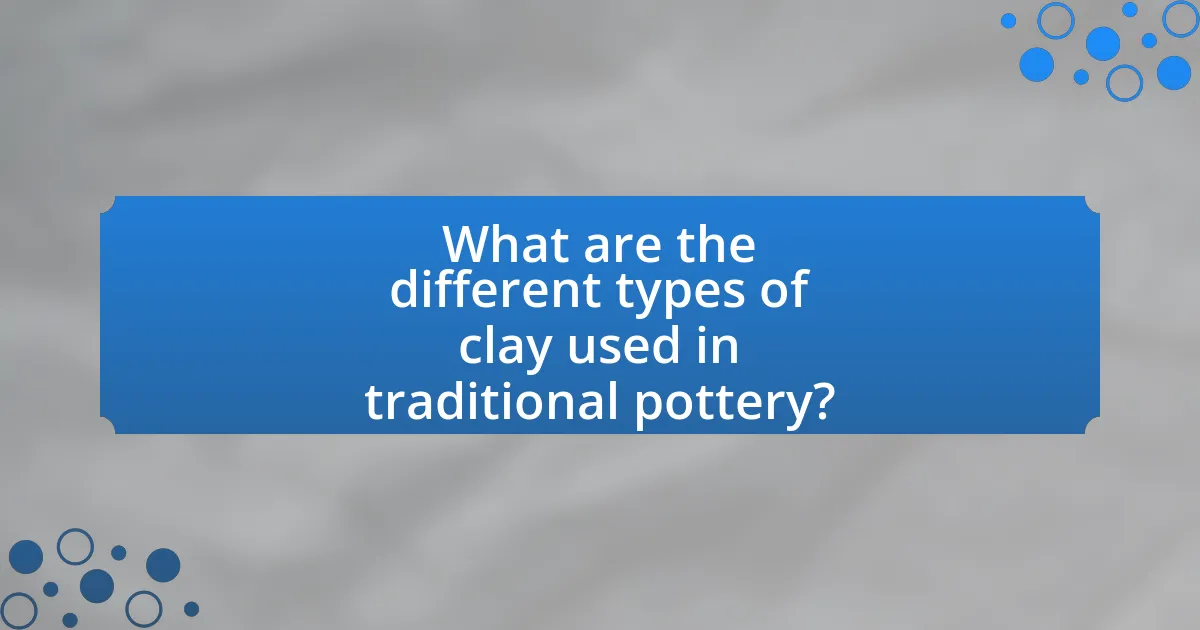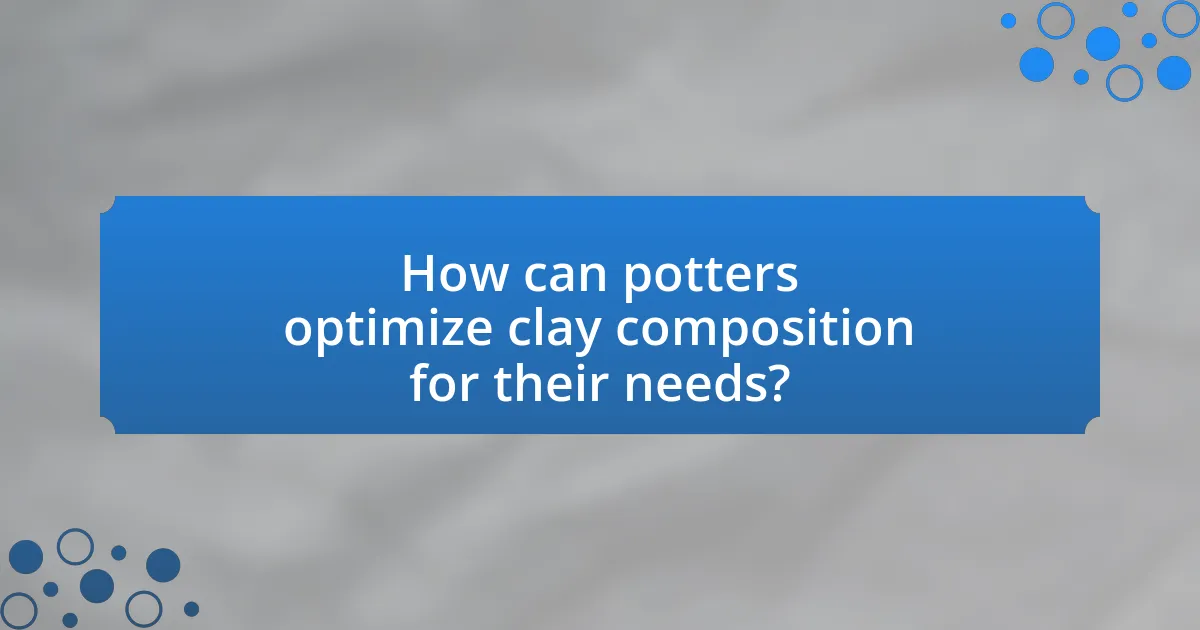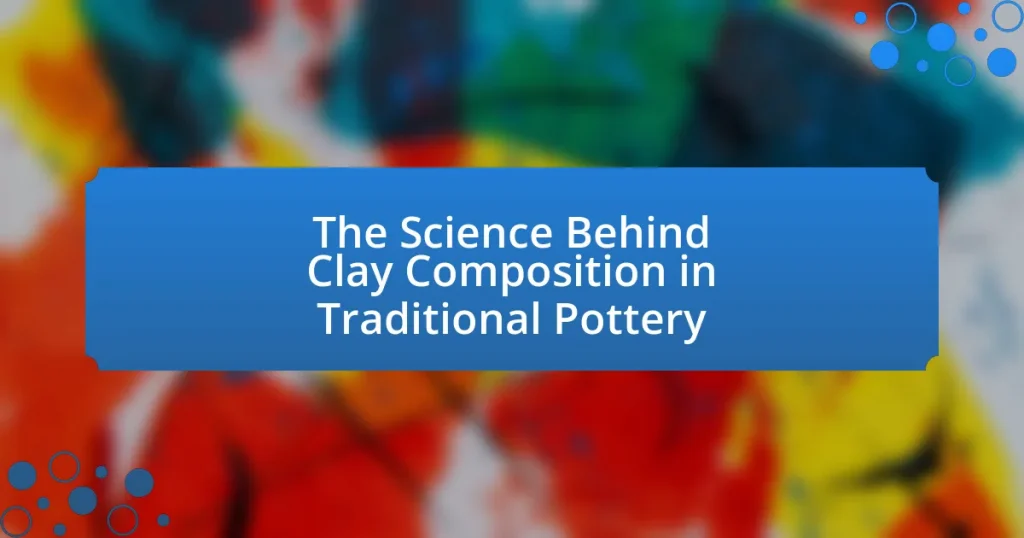The article focuses on the science behind clay composition in traditional pottery, emphasizing the mineralogical and chemical properties of clay materials, primarily aluminosilicates. It explores how different clay types, such as earthenware, stoneware, and porcelain, influence pottery quality through their unique compositions, affecting factors like plasticity, firing temperature, and durability. The article also discusses the primary components of clay, the impact of various clay minerals on final products, and the importance of understanding clay composition for potters to optimize their work. Additionally, it addresses regional variations in clay types, traditional sourcing methods, and best practices for blending different clay types to achieve desired pottery outcomes.

What is the Science Behind Clay Composition in Traditional Pottery?
The science behind clay composition in traditional pottery involves the mineralogical and chemical properties of clay materials, primarily composed of aluminosilicates. These minerals, such as kaolinite, illite, and montmorillonite, determine the plasticity, shrinkage, and firing temperature of the clay. For instance, kaolinite, which is prevalent in high-quality porcelain, has a low shrinkage rate and high firing temperature, making it suitable for fine pottery. The specific ratios of silica, alumina, and water in the clay mixture influence the final product’s strength and durability. Research indicates that the particle size distribution and mineral content directly affect the workability and thermal properties of the clay, which are critical for achieving desired artistic and functional characteristics in pottery.
How does clay composition influence pottery quality?
Clay composition directly influences pottery quality by determining the physical and chemical properties of the final product. Different clay types, such as earthenware, stoneware, and porcelain, have varying mineral contents, which affect factors like plasticity, firing temperature, and durability. For instance, high alumina content in stoneware clay enhances strength and thermal resistance, making it suitable for functional ware. Conversely, earthenware, with its lower firing temperature and higher porosity, results in more fragile pottery. Studies show that specific mineral combinations, such as kaolinite and feldspar, contribute to improved vitrification, leading to a denser and more water-resistant final product.
What are the primary components of clay used in pottery?
The primary components of clay used in pottery are alumina, silica, and water. Alumina, which constitutes about 20-30% of clay, provides plasticity, allowing the clay to be shaped easily. Silica, making up approximately 50-60% of clay, acts as a flux and helps in the vitrification process during firing, contributing to the strength and durability of the final product. Water, typically present in varying amounts, is essential for the workability of clay, enabling it to be molded and shaped before it is fired. These components work together to create a versatile material suitable for various pottery techniques.
How do different clay minerals affect the final product?
Different clay minerals significantly influence the properties and characteristics of the final pottery product. For instance, kaolinite, a common clay mineral, contributes to a smooth texture and high plasticity, making it ideal for fine porcelain. In contrast, illite can enhance the strength and durability of the pottery due to its unique particle size and shape, which improves the bonding during firing. Additionally, montmorillonite, known for its high water absorption, can lead to increased shrinkage and warping if not properly managed. These mineralogical differences directly affect the thermal stability, color, and overall aesthetic of the finished pottery, demonstrating the critical role of clay composition in traditional pottery practices.
Why is understanding clay composition important for potters?
Understanding clay composition is crucial for potters because it directly influences the properties and behavior of the clay during shaping, firing, and glazing. Different clay compositions affect factors such as plasticity, shrinkage, and firing temperature, which are essential for achieving desired results in pottery. For instance, stoneware clay, which contains a higher percentage of feldspar, can withstand higher temperatures and is less porous than earthenware clay, making it suitable for functional ware. This knowledge allows potters to select the appropriate clay type for their specific projects, ensuring durability and aesthetic quality in their finished pieces.
How does clay composition impact firing temperatures?
Clay composition significantly impacts firing temperatures due to the mineral content and particle size of the clay. Different minerals, such as kaolinite, illite, and montmorillonite, have varying thermal properties, which influence the temperature required for vitrification and strength development. For instance, kaolinite, a primary component of porcelain, typically matures at lower temperatures (around 1200°C) compared to clays rich in iron or alumina, which may require higher temperatures to achieve similar results. Additionally, the presence of organic materials or impurities can lower the firing temperature needed for the clay to reach its optimal state. This relationship between clay composition and firing temperatures is crucial for potters to achieve desired characteristics in their ceramic products.
What role does clay composition play in glazing and surface finish?
Clay composition significantly influences glazing and surface finish by determining the interaction between the clay body and the glaze during firing. The mineral content, particle size, and plasticity of the clay affect how well the glaze adheres, its final appearance, and the overall durability of the pottery. For instance, high alumina content in clay enhances glaze adhesion and reduces crazing, while iron content can lead to varied glaze colors and textures. Studies show that specific clay compositions can yield different surface finishes, such as matte or glossy, based on their chemical properties and firing conditions.

What are the different types of clay used in traditional pottery?
The different types of clay used in traditional pottery include earthenware, stoneware, and porcelain. Earthenware is a porous clay that is fired at low temperatures, making it suitable for decorative pottery and functional items. Stoneware is a denser clay that is fired at higher temperatures, resulting in a durable and non-porous material ideal for functional ware. Porcelain, known for its fine texture and translucence, is fired at very high temperatures and is often used for high-quality tableware and artistic pieces. These distinctions are based on the clay’s mineral composition and firing temperatures, which influence the final properties of the pottery.
How do earthenware, stoneware, and porcelain differ in composition?
Earthenware, stoneware, and porcelain differ in composition primarily based on their clay content and firing temperatures. Earthenware is made from clay that contains a high percentage of iron and is fired at lower temperatures, typically between 1,000 to 1,150 degrees Celsius, resulting in a porous and opaque material. Stoneware, on the other hand, consists of a denser clay body that includes feldspar and is fired at higher temperatures, around 1,200 to 1,300 degrees Celsius, making it more durable and non-porous. Porcelain is composed of kaolin clay, feldspar, and quartz, and is fired at even higher temperatures, usually between 1,200 to 1,400 degrees Celsius, resulting in a translucent and very strong material. These differences in composition and firing temperatures lead to distinct physical properties and uses for each type of pottery.
What specific properties make earthenware suitable for certain pottery styles?
Earthenware is suitable for certain pottery styles due to its porous nature, low firing temperature, and ability to retain vibrant colors. The porous quality allows for breathability, making it ideal for functional pottery like planters and cooking vessels, as it can absorb moisture and enhance flavor. The low firing temperature, typically between 1,830°F and 2,200°F, enables artisans to create intricate designs without risking damage to the piece. Additionally, earthenware’s capacity to hold bright glazes and pigments supports decorative pottery styles, as seen in traditional Mexican Talavera pottery, which showcases vivid colors and intricate patterns. These properties collectively make earthenware a versatile choice for both functional and decorative pottery styles.
How does stoneware’s composition contribute to its durability?
Stoneware’s composition, primarily consisting of a mixture of clay, feldspar, and quartz, significantly contributes to its durability. The high firing temperature, typically between 1,200 to 1,300 degrees Celsius, vitrifies the clay, creating a dense and non-porous structure that enhances strength and resistance to chipping and cracking. Additionally, the presence of feldspar acts as a flux, lowering the melting point and promoting the formation of a glassy phase that further increases the material’s toughness. This combination of materials and firing techniques results in stoneware that can withstand thermal shock and is less likely to absorb moisture, making it ideal for both functional and decorative uses.
What are the regional variations in clay types for pottery?
Regional variations in clay types for pottery include earthenware, stoneware, and porcelain, each characterized by distinct mineral compositions and firing temperatures. For instance, earthenware, commonly found in regions like Mexico and the Mediterranean, contains high levels of iron oxide, resulting in a reddish color and lower firing temperatures around 1,000 to 1,150 degrees Celsius. In contrast, stoneware, prevalent in areas such as Germany and the UK, is made from a mixture of clay and feldspar, allowing for higher firing temperatures of 1,200 to 1,300 degrees Celsius, which results in a durable and non-porous finish. Porcelain, originating from China, is composed of kaolin, feldspar, and quartz, requiring firing temperatures above 1,300 degrees Celsius, leading to its characteristic translucency and strength. These variations are influenced by local geological conditions, which dictate the availability and composition of clay deposits.
How do local geological conditions influence clay composition?
Local geological conditions significantly influence clay composition by determining the mineral content, particle size, and organic matter present in the clay. For instance, the weathering of specific parent rocks in a region leads to the formation of distinct clay minerals such as kaolinite, illite, or montmorillonite, which are influenced by factors like temperature, rainfall, and vegetation. Research indicates that areas with high volcanic activity often produce clays rich in volcanic ash, resulting in unique properties suitable for pottery. Additionally, sedimentary environments can yield clays with varying textures and colors, directly affecting the workability and firing characteristics of the clay used in traditional pottery.
What traditional methods are used to source and prepare clay in different cultures?
Traditional methods used to source and prepare clay vary across cultures, often involving local geological knowledge and specific techniques. For instance, in Native American pottery, clay is typically sourced from riverbanks or specific clay pits, where artisans hand-select the material based on its texture and color. After extraction, the clay is processed by removing impurities, often through a process of soaking and sieving, to achieve a fine consistency suitable for shaping.
In Japan, traditional pottery, such as that from the Mino region, involves sourcing clay from nearby riverbeds. Artisans then knead the clay by hand, incorporating water to achieve the desired plasticity. This method emphasizes the tactile relationship between the potter and the clay, allowing for a deep understanding of the material’s properties.
Similarly, in African cultures, such as the Yoruba of Nigeria, clay is often sourced from specific locations known for their quality. The preparation involves sun-drying the clay before grinding it into a fine powder, which is then mixed with water to create a workable paste. This method reflects a communal knowledge of local resources and techniques passed down through generations.
These traditional sourcing and preparation methods highlight the cultural significance and practical knowledge embedded in pottery practices worldwide.

How can potters optimize clay composition for their needs?
Potters can optimize clay composition by adjusting the ratios of primary components such as kaolin, ball clay, feldspar, and silica to achieve desired properties like plasticity, strength, and firing temperature. For instance, increasing kaolin enhances whiteness and reduces plasticity, while adding ball clay improves workability. Research indicates that a typical stoneware clay body consists of approximately 25-30% kaolin, 25-30% ball clay, 20-30% feldspar, and 10-20% silica, allowing potters to tailor their mixtures based on specific project requirements. This precise formulation enables potters to create clays that perform optimally for hand-building, throwing, or sculpting, ensuring the final product meets aesthetic and functional standards.
What techniques can potters use to test clay composition?
Potters can use several techniques to test clay composition, including visual inspection, water absorption tests, and firing tests. Visual inspection allows potters to assess the texture, color, and particle size of the clay, which can indicate its mineral content. Water absorption tests involve measuring how much water the clay can absorb, providing insights into its porosity and plasticity. Firing tests, where clay samples are shaped and then fired at various temperatures, help potters evaluate the clay’s behavior during the firing process, revealing its shrinkage, strength, and final color. These methods are widely recognized in pottery practices for determining the suitability of clay for specific applications.
How can potters adjust clay mixtures for specific pottery outcomes?
Potters can adjust clay mixtures for specific pottery outcomes by altering the proportions of clay, sand, and additives like grog or feldspar. For instance, increasing the sand content enhances the clay’s strength and reduces shrinkage, making it suitable for functional ware. Conversely, adding more clay improves plasticity, which is essential for intricate designs. The use of additives like grog can provide texture and reduce warping during firing. Research indicates that specific ratios can yield desired characteristics; for example, a mixture of 50% stoneware clay and 50% grog is often used for durable stoneware pottery.
What are the best practices for blending different clay types?
The best practices for blending different clay types include understanding the properties of each clay, maintaining a consistent moisture level, and conducting small test batches before full-scale mixing. Each clay type has unique characteristics such as plasticity, shrinkage rates, and firing temperatures, which can affect the final product. Maintaining a consistent moisture level ensures that the clays blend uniformly and reduces the risk of cracking during drying and firing. Conducting small test batches allows potters to evaluate the blend’s workability and firing results, ensuring that the final mixture meets desired specifications. These practices are supported by the fact that successful clay blending often leads to improved workability and enhanced aesthetic qualities in pottery.
What common challenges do potters face with clay composition?
Potters commonly face challenges with clay composition, including issues related to plasticity, shrinkage, and firing temperature. Plasticity affects the workability of the clay; if the composition lacks sufficient plastic materials, it can become difficult to shape. Shrinkage occurs during drying and firing, which can lead to cracks or warping if the clay mixture is not balanced correctly. Additionally, firing temperature can vary based on the clay’s mineral content; using inappropriate compositions can result in poor vitrification or even complete failure of the pottery. These challenges highlight the importance of understanding the specific properties of different clay types and their interactions during the pottery-making process.
How can potters troubleshoot issues related to clay shrinkage and cracking?
Potters can troubleshoot issues related to clay shrinkage and cracking by adjusting the moisture content of the clay and ensuring proper drying techniques. Maintaining an optimal moisture level prevents excessive shrinkage, which can lead to cracking during the drying process. Additionally, potters should implement slow and even drying methods, such as covering pieces with plastic to control evaporation rates, which helps minimize stress on the clay. Research indicates that uneven drying can cause differential shrinkage, leading to cracks, thus emphasizing the importance of consistent drying conditions.
What tips can help potters achieve consistent results with clay composition?
To achieve consistent results with clay composition, potters should meticulously measure and mix their clay ingredients. Accurate measurement ensures that the proportions of primary components, such as kaolin, feldspar, and quartz, remain uniform, which is crucial for predictable firing outcomes. Additionally, potters should conduct regular tests of their clay bodies by creating test tiles and firing them under the same conditions to evaluate the results. This practice allows for adjustments to be made based on the performance of the clay after firing, ensuring that the desired characteristics, such as texture and strength, are consistently achieved.


